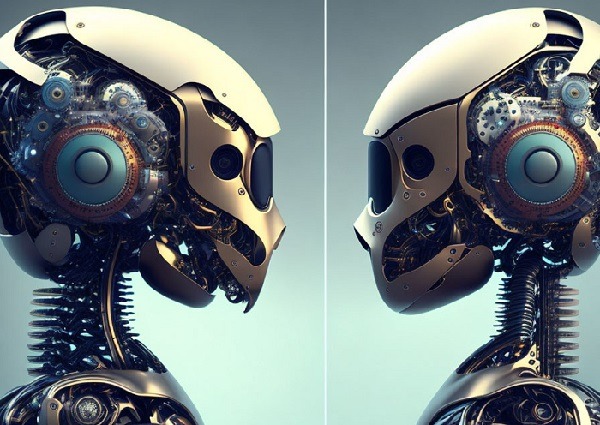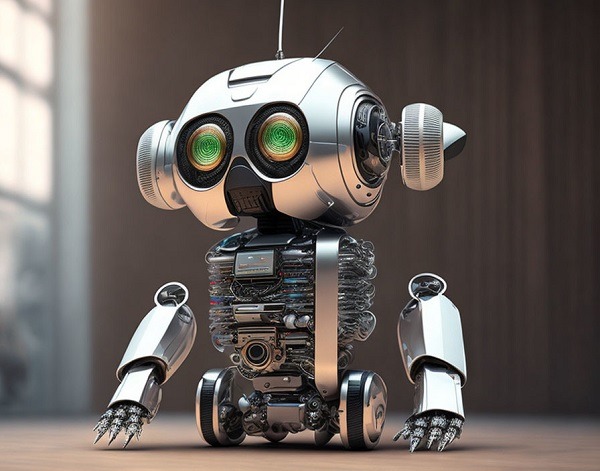What types of artificial intelligence are there? Meet them all!
The wide diversity of artificial intelligence tools currently available is a reflection of the advancement and maturation of this technology. However, this variety of applications is only possible because there are several types of artificial intelligence, each with its specific characteristics and applications.
With the growing popularity of artificial intelligence technology, we are seeing new intelligent tools emerge daily that have the potential to help us in various areas of everyday life. An example of the wide range of options available is in the article that we already published here on AppTuts, highlighting some fantastic artificial intelligence tools.
Therefore, in this article we are going to present an overview of the types of artificial intelligence, what are their capabilities, how they learn and their main applications to help humans in everyday life.
What is artificial intelligence?
Artificial intelligence is an ever-evolving field within computer science. At first, this area is focused on the development of algorithms, systems, and tools capable of performing tasks that previously required the intervention of human intelligence.
Due to the mathematical modeling of cognitive processes, artificial intelligence has the ability to develop solutions that can be applied in different sectors of human life, ranging, for example, from industry to marketing and entertainment.
In addition, these systems have the ability to learn from information collected in databases, which allows them to be trained to understand complex issues for making accurate decisions.
Thus, although artificial intelligence is a disruptive technology and has advanced significantly in recent times, it is still not able to completely replace human intelligence. Still, it can be quite useful in your professional life. An example is these Artificial Intelligence Websites to Increase Productivity.

What are the types of artificial intelligence?
Currently, there are three main types of artificial intelligence that stand out both in research and in practical application: Artificial Narrow Intelligence (ANI), Artificial General Intelligence (AGI), and Artificial Superintelligence (ASI).
Limited Artificial Intelligence
First, we have Limited Artificial Intelligence. This is the most common type of artificial intelligence, being able to perform specific tasks with a high level of accuracy, efficiency, and speed. It is used, for example, in voice recognition tools, such as smartphones and virtual assistants that interpret the words spoken by the user and perform the corresponding actions.
General Artificial Intelligence
This is an advanced form of artificial intelligence, more focused on developing systems capable of performing tasks that require a wide range of cognitive abilities. In addition, this type of AI has the ability to learn and understand new concepts, as well as perform logical reasoning and develop solutions to complex problems.
Artificial Superintelligence
It is an even more advanced type of artificial intelligence capable of even surpassing human cognitive ability, with a level of intelligence and skill that surpasses the average of any individual. Thus, this type of artificial intelligence has enormous potential to impact society and the way people live, above all, how they work and relate.
Did you know that it is possible to create images from text with artificial intelligence? Click and find out how.
What kind of abilities does artificial intelligence have?
The three types of artificial intelligence described above can be classified according to four distinct capabilities or abilities. These characteristics are directly related to the level of development achieved by each type of AI and can be observed to a greater or lesser extent in each of them.
The four distinct capabilities are reactive machines, limited memory, theory of mind, and self-awareness. Let’s see now what each of them means.
Reactive machines
This capability is usually present in robotics and industrial automation applications, where it is necessary for the machine to respond quickly and accurately to a series of instructions and sensor programming.
For example, a mechanical arm on an assembly line can be programmed to act as a reactive machine to perform repetitive tasks quickly and accurately without having to store information or plan these actions in advance.
Limited memory
This characteristic refers to artificial intelligence systems that have limitations in their ability to store data in the long term. The ability to store information is an essential feature of human memory. However, in the case of AIs, this can be a very limited ability.
In this sense, systems with limited memory often need to resort to machine learning techniques, which allow them to learn from the collected data and improve their performance over time.
Theory of mind
Theory of mind is a complex cognitive skill that allows humans to understand that other people have their own beliefs and motivations. Therefore, many actions are not based on logic, but on personal beliefs, feelings, and desires.
In artificial intelligence, theory of mind is a field of research that seeks to understand how systems can develop this ability to understand more complex things to, for example, interact more naturally with human beings.
Self-awareness
Finally, we have Self-Awareness. This is the ability of an artificial intelligence system to perceive and understand itself, as well as the environment around it. This ability allows the system to use information about itself to autonomously make decisions and improve its performance.
In practice, this means that a self-aware system can identify its own strengths and weaknesses in order to learn from its own mistakes. This approach is also known as “reinforcement learning” and is one of the most advanced capabilities of artificial intelligence.
However, it is worth noting that this is still a developing capability and there are many challenges to be overcome to make it a reality in artificial intelligence. In addition, there are ethical issues that need to be taken into account, such as the possibility that these self-aware systems make unpredictable or dangerous decisions for humanity.

How does artificial intelligence learn?
Artificial intelligence learns through machine learning algorithms, which are codes capable of recognizing the patterns that exist in a data set and making predictions based on these identified patterns.
In principle, there are five main forms of machine learning, which are supervised learning, unsupervised learning, neural network learning, natural language processing, and genetic algorithm learning. See below for a little about each one of them.
Supervised Learning
This is one of the main types of machine learning. In it, the algorithm is fed with a set of previously labeled data. Each entry in the dataset is accompanied by a correct answer (a label) that indicates what the expected output of the algorithm should be for that entry.
When artificial intelligence is trained by this methodology, it begins to learn how to correctly predict responses to new input data that has not yet been labeled, but which can be associated with other data already labeled.
Unsupervised Learning
In this other type, the algorithm is fed a set of unlabeled data and must find patterns and structures in that data on its own. As there are no such “labels” to rely on, the artificial intelligence will have to discover structures in the data that may be useful for further analysis.
Learning by Neural Networks
In this kind of approach to machine learning, the human brain is the biggest inspiration. Thus, an interconnected set of processing units called “artificial neurons”, are organized in layers, being able to learn from data.
In this process, a set of data is presented to the network, which adjusts the connections between neurons to minimize the difference between the expected outputs. This process is repeated over and over again until the network is able to make accurate predictions on never-before-seen data.
Learning by Natural Language Processing
In this type of learning, systems are trained to understand, interpret and generate natural human language, detecting patterns and relationships between words and phrases. Currently, it is used in a variety of applications, such as machine translation, chatbots, and personal assistants, among others applications.
Learning by Genetic Algorithms
Finally, we have Learning by Genetic Algorithms. This approach is based on evolutionary principles and is inspired by the processes of natural selection and reproduction present in biological evolution. The aim is to find solutions to complex problems.
Genetic Algorithms create a large number of solutions to a given problem, represented by a set of numerical values or other types of data. Then, the algorithm evaluates the aptitude of each of these solutions to solve the problem in question.
What are the main applications of artificial intelligence?
Currently, artificial intelligence has been adopted by many companies and is present in several tools of our daily lives. Its applications are vast and diverse, impacting different areas of human life.
From virtual assistants to medical diagnostic systems, AI is changing the way we interact with technology, our work, and the world around us. In addition, it is important to highlight that there are several types of artificial intelligence. Therefore, it is also interesting to know some of the main areas where AI can be applied.
Main applications:
- Robotics: in this field, AI is used to develop autonomous systems that work without the need for human interference, which is especially positive in the case of work in dangerous or unhealthy environments.
- Medicine: Artificial intelligence is a promising technology for the analysis of diagnoses and also in the development of new drugs. In addition, it can assist during remote surgeries performed by robots.
- Agriculture: AI has been used for some time in the field, especially in the control of agricultural equipment, increasing the efficiency of food production. It also provides accurate information about planting a rural property.
- Education: the personalization of learning, the creation of new educational books, and the creation of video lessons without human intervention are some of the applications of artificial intelligence in the field of education.
- Finance: AI can predict trends, analyze market moods, and manage risk. Furthermore, it can be used by financial institutions to detect accounting inconsistencies and fraud.
- Energy: The technology can be used for managing systems, optimizing energy consumption, forecasting demand, and creating energy networks.
- Marketing: artificial intelligence is already used in a multitude of tools that optimize work in this segment, with the production of texts, images, and even complete advertising campaigns.
- Human resources: in this area, artificial intelligence is used to automate recruitment and resume screening tasks. With it, the hiring analysis process is faster and more efficient.
- Government: AI can be used to manage massive amounts of data for an entire country. With it, it is possible to predict future trends and events, such as natural disasters, wars, and epidemics.
What are the best-known artificial intelligence?
Before the emergence of ChatGPT, the chatbot developed by the company OpenAI, the artificial intelligence most present in our daily lives as those of virtual assistants. The best-known in this category are Alexa, Siri, and Google Assistant. Previously, we’ve talked here on AppTuts about ChatGPT, teaching what it is, what it’s for, and how to use it. We also present the Top 10 ChatGPT Alternatives.
These virtual assistants have become an integral part of our daily lives, allowing people to perform simple tasks like making a phone call, setting an alarm, sending a text message, or searching the internet with just a voice command.
However, the popularization of artificial intelligence opened space for new tools and applications that stood out in the market and quickly became known. Among them, we can mention the service chatbots, which use AI to offer support and solve the problems of users of a given service.
In this sense, a very popular platform is Dall-E, also developed by OpenAI. It is able to generate digital images from textual descriptions. Dall-E creates highly realistic and detailed images, which makes it a promising tool for designers and marketers.
Similarly, another artificial intelligence platform is SurferSEO, which uses the technology for SEO analysis. It helps identify the most relevant keywords for the content and optimize the text for better search engine results. It is a very useful tool for website owners, bloggers, and digital marketers.
Conclusion
Finally, artificial intelligence is a broad and diverse technology, with different types and applications, as we saw earlier. Each type has its own characteristics and functionalities, which are used in different areas, such as medicine, agriculture, transport, and security, among others.
Also, check: Artificial intelligence websites that create music: The Top 4!





